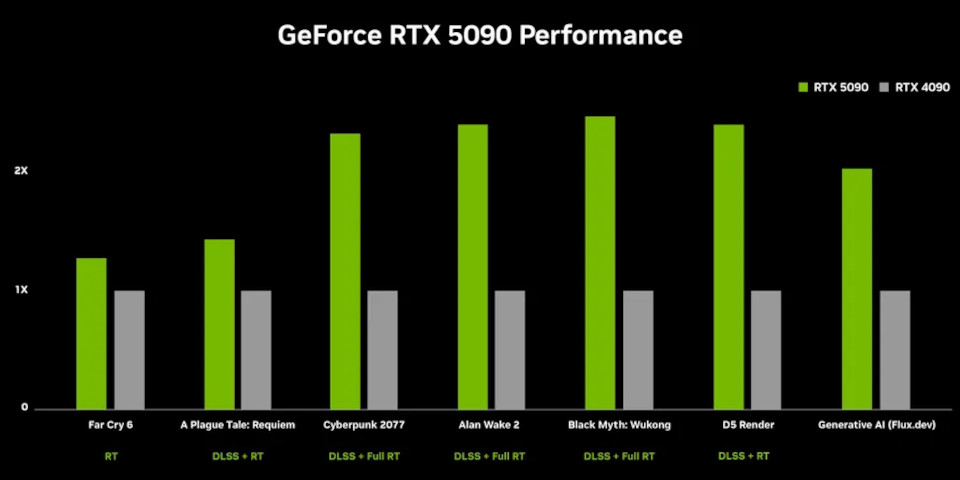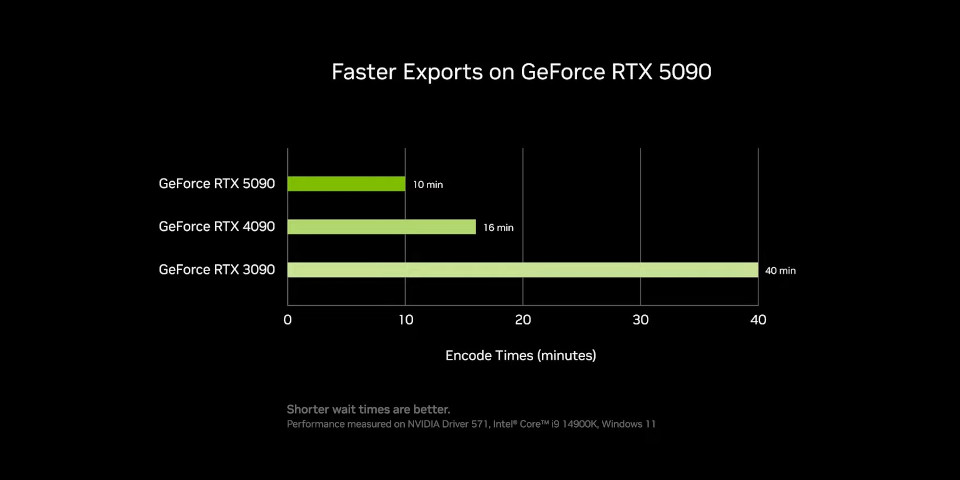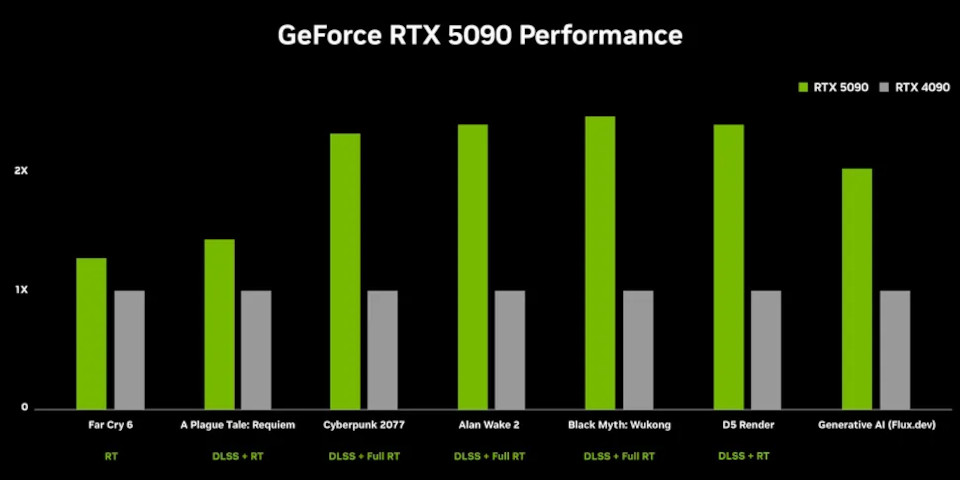NVIDIA has unveiled the GeForce RTX 5090, GeForce RTX 5080, GeForce RTX 5070 Ti and GeForce RTX 5070: the top-of-the-range cards in its GeForce RTX 50 Series of consumer GPUs.
The GPUs, which will all be available by February, and which are priced between $1,999 and $549, are the first desktop cards to use NVIDIA’s next-gen Blackwell GPU architecture.
Although primarily gaming cards, NVIDIA also markets the RTX 50 Series at artists, so below, we’ve rounded up their key specs for DCC work, and performance comparisons for CG software.
NVIDIA’s GeForce RTX 50 Series GPUs and previous-gen counterparts RTX 5090 RTX 4090 RTX 5080 RTX 4080 RTX 5070 Ti RTX 4070 Ti RTX 5070 RTX 4070 Architecture Blackwell Ada Lovelace Blackwell Ada Lovelace Blackwell Ada Lovelace Blackwell Ada Lovelace CUDA cores 21,760 16,384 10,752 9,728 8,960 7,680 6,144 5,888 Tensor cores* 680 512 336 304 280 240 192 184 RT cores* 170 128 84 76 70 60 48 46 Base clock (GHz) 2.41 2.23 2.62 2.21 2.45 2.31 2.51 1.92 Boost clock (GHz) 2.01 2.52 2.30 2.51 2.30 2.61 2.16 2.48 Compute performance
FP32 (Tflops)* 104.8 82.6 56.3 48.7 44.4 40.1 31.0 29.2 GPU memory 32 GB GDDR7 24GB
GDDR6X 16 GB GDDR7 16GB
GDDR6X 16 GB GDDR7 12GB
GDDR6X 12 GB GDDR7 12GB
GDDR6X TGP 575W 450W 360W 320W 300W 285W 250W 200W Release date 2025 2022 2025 2022 2025 2023 2025 2023 MSRP at launch $1,999 $1,599 $999 $1,199 $749 $799 $549 $599 *Data taken from third-party websites.
Key specifications for DCC work
In terms of core specs, the new GeForce RTX 50 Series GPUs are a sizeable improvement over their counterparts from the current-generation GeForce RTX 40 Series.
All have all higher counts of the three key hardware core types: CUDA for general GPU compute, Tensor for AI operations, and RT for hardware-accelerated ray tracing.
The RT cores are also now fourth-generation, and the Tensor cores fifth-generation, although NVIDIA hasn’t provided much detail on how that will affect GPU rendering performance.
What will definitely affect GPU rendering is the increased GPU memory capacity of the top-of-the-range GeForce RTX 5090: up to 32GB, from 24GB in the current-gen RTX 4090.
The GeForce RTX 5070 Ti also has more GPU memory than its predecessor, although there is no change with either the GeForce RTX 5080 or GeForce RTX 5070.
In addition, the entire GeForce 50 Series uses the latest GDDR7 memory, rather than the older GDDR6X memory used in the GeForce RTX 40 Series.
There is less change in display connectivity: the GeForce 50 Series cards have one HDMI and three DisplayPort connectors, the same as the GeForce RTX 40 Series.
However, they support DisplayPort 2.1, the latest version of the standard – and will support the upcoming DisplayPort 2.1b – whereas the GeForce RTX 40 Series supports DisplayPort 1.4a.
Those increases in processing power come with a corresponding increase in power consumption – all four GeForce RTX 50 Series cards have a higher Total Graphics Power than their precursors.
However, they are also more compact – unlike the high end of the GeForce RTX 40 Series, all are dual-slot cards – and most of them are cheaper than their predecessors, at least at launch.
The exception is the GeForce RTX 5090, which has a launch price of $1,999, up $400 from the GeForce RTX 4090, although NVIDIA claims that it offers double the overall performance.

Benchmarks and performance in DCC applications
Given that GeForce RTX 50 Series are gaming cards, most of the performance comparisons that NVIDIA has released are for games rather than CG software.
One exception is architectural GPU renderer D5 Render.
The comparison chart above shows over a 2x increase in performance on the GeForce RTX 5090 compared to the current-gen RTX 4090, presumably using the standard D5 Render Benchmark.

Although NVIDIA has a blog post on how the new cards will affect creative workflows, it focuses very much on generative AI rather than DCC software.
However, it does feature a section on video editing and video production, which claims that the GeForce RTX 5090 can export video “60% faster” than the current-gen GeForce RTX 4090.
The comparison chart above is taken from a video on DaVinci Resolve, although the blog post also mentions Premiere Pro.
Pricing and release dates
The GeForce RTX 5090 and 5080 will be available on 30 January, priced at $1,999 and $999.
The GeForce RTX 4070 Ti and 4070 will be available in February, priced at $749 and $549.
Read NVIDIA’s announcement of the GeForce RTX 50 Series GPUs
Find specifications for the GeForce RTX 50 Series GPUs on NVIDIA’s website
Have your say on this story by following CG Channel on Facebook, Instagram and X (formerly Twitter). As well as being able to comment on stories, followers of our social media accounts can see videos we don’t post on the site itself, including making-ofs for the latest VFX movies, animations, games cinematics and motion graphics projects.



